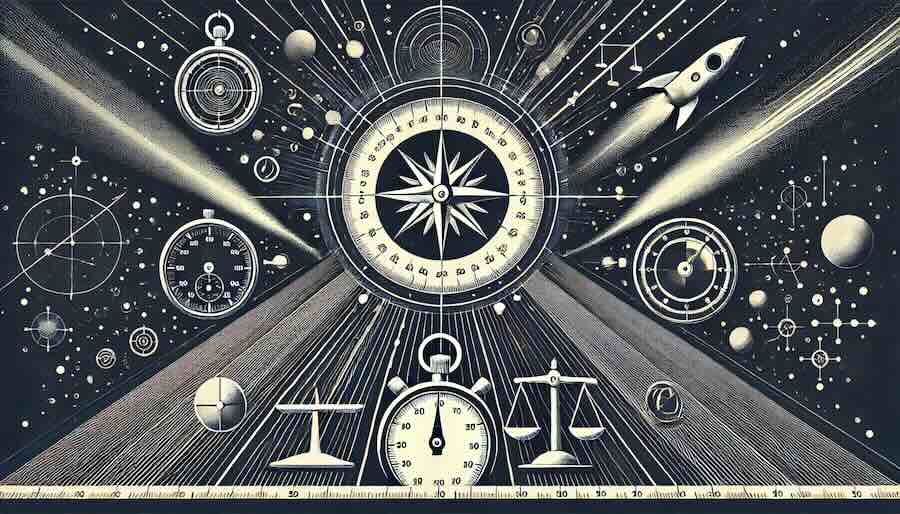Shoulders of Measurement Giants : Small
January 23, 2025

Shoulders of Measurement Giants—Small
Humanity has spent centuries peering deeper into the microscopic realm, evolving from simple magnifying glasses to today’s super-resolution tools. Every breakthrough reveals new layers of reality—from our first glimpse of “cells” to imaging individual atoms, and ultimately, the question of how small we can go.
1. Early Magnification and the First Microscopes
- 1st Century AD: Romans discovered glass could magnify objects, leading to simple magnifying glasses.
- 14th Century: Italian spectacle makers honed eyeglasses, improving vision and seeding future optical devices.
- 1590: Hans and Zacharias Janssen built the first compound microscope, stacking lenses in a tube for about 9× magnification.
2. Advancements in Microscopy and Cellular Discovery
- 1665: Robert Hooke’s Micrographia showcased microscopic observations, coining the term “cell” while studying cork.
- 1674: Antonie van Leeuwenhoek, using self-made microscopes, discovered bacteria and protozoa (his “animalcules”), unveiling the microbial world.
3. Enhancements in Optical Microscopy
- 1830: Joseph Jackson Lister reduced chromatic aberration with carefully spaced weaker lenses, yielding clearer images.
- 1878: Ernst Abbe established the diffraction limit, tying microscope resolution to light’s wavelength—defining a fundamental boundary for classical optics.
4. Electron Microscopy and Atomic Resolution
- 1931: Ernst Ruska and Max Knoll pioneered the transmission electron microscope (TEM), leveraging electron beams for heightened magnification and resolution.
- 1953: Frits Zernike’s phase-contrast microscope allowed scientists to study transparent, living specimens without staining.
5. Scanning Probe Microscopy and Nanotechnology
- 1981: Gerd Binnig and Heinrich Rohrer introduced the scanning tunneling microscope (STM), imaging individual atoms on conductive surfaces—sparking the nanotech revolution.
- 1986: Binnig, Quate, and Gerber developed the atomic force microscope (AFM), measuring atomic-scale forces on both conductive and non-conductive materials.
6. Modern Super-Resolution Techniques
- 1990s: Methods like STED (Stimulated Emission Depletion) and PALM (Photoactivated Localization Microscopy) surpassed the diffraction limit, allowing imaging at the nanometer scale.
7. Probing Subatomic Scales
Even with the ability to image single atoms, probing beneath the atomic level demands new methods:
- Early Particle Scattering (Rutherford’s Experiment, 1909)
By bombarding thin gold foil with alpha particles, Ernest Rutherford uncovered the atomic nucleus, revealing that most atomic mass resides in a tiny central region. - Particle Accelerators and Colliders
Facilities like the Large Hadron Collider (LHC) crash particles at near-light speeds. Their scattering patterns, energy signatures, and emerging particles help scientists study fundamental constituents—quarks, leptons, and bosons. - Wave-Particle Duality
In quantum mechanics, particles (e.g., electrons) exhibit wave-like properties, complicating the notion of measuring a fixed “size.” Instead, we speak in terms of cross-sections rather than diameters. - Measuring Nuclear and Particle Scales
High-energy electron scattering (deep inelastic scattering) has mapped the internal structure of protons and neutrons, confirming the existence of quarks—pushing measurement far below an atom’s scale.
8. Theoretical Limits: Planck Scale
As technology advances, theoretical physics hints at an ultimate lower bound:
- Planck Length (~1.616×10⁻³⁵ m)
Derived from fundamental constants, it’s suggested to be the “smallest meaningful length” in quantum gravity theories—below which conventional distance might lose its meaning. - Heisenberg’s Uncertainty Principle
At subatomic scales, measuring one property (like position) blurs another (like momentum). Seeking precision in both breaks down at extreme resolutions.
We haven’t proven measurement must end at the Planck scale, but it stands as a frontier where our known physics may not hold.
Key Milestones in Measuring Smaller Scales
| Date | Milestone | Method/Instrument |
|---|---|---|
| 1st Century AD | Glass used for magnification | Magnifying glasses |
| 14th Century | Eyeglasses improve vision | Single-lens spectacles |
| 1590 | First compound microscope | Multiple lenses in a tube |
| 1665 | Observation & naming of “cells” | Compound microscope (Hooke) |
| 1674 | Discovery of microorganisms (“animalcules”) | Single-lens microscope (Leeuwenhoek) |
| 1830 | Reduced chromatic aberration | Improved lens combos (Lister) |
| 1878 | Defined diffraction limit | Theoretical framework (Abbe) |
| 1909 | Uncovered atomic nucleus (Rutherford) | Alpha-particle scattering |
| 1931 | Electron-based imaging | Transmission electron microscope (TEM) |
| 1953 | Observing transparent, living specimens | Phase-contrast microscope (Zernike) |
| 1981 | Imaging individual atoms on conductive surfaces | Scanning tunneling microscope (STM) |
| 1986 | Atomic resolution on non-conductive surfaces | Atomic force microscope (AFM) |
| 1990s | Surpassing the diffraction limit | Super-resolution microscopy (STED, PALM) |
| 2000s & beyond | Probing subatomic particles (quarks, leptons, etc.) | High-energy colliders, deep inelastic scattering |
| Theoretical | Potential smallest scale (Planck length) | Quantum gravity concepts |
Concluding Thought
Over the centuries, these milestones have unveiled hidden worlds, reshaping our understanding of biology, chemistry, and particle physics. From detecting microbes to discerning the architecture of atoms—and even subatomic elements—each step redefines how we perceive and investigate the very small. As we forge ahead, it’s possible that at some frontier, the notion of “measurement” itself may transform—much like how cosmic distances once challenged our ancestors’ grasp of the universe’s scale. Just as exploring the enormous magnifies our cosmic perspective, chasing the infinitesimal reveals profound puzzles about the fabric of reality.
